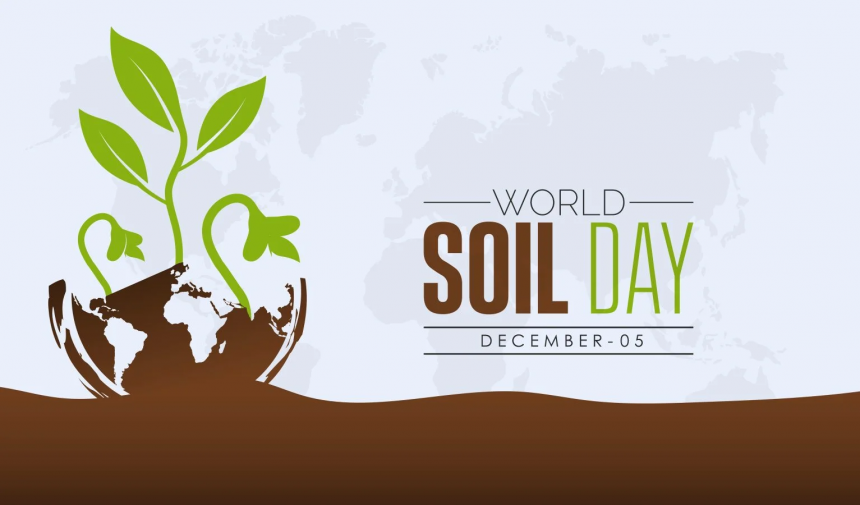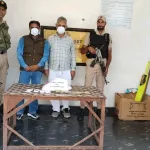A vital resource for survival of life on this planet; soil constitutes a critical component of the natural system and is an important contributor to the human wealth through its contribution to food, water and energy security and as a mitigator to biodiversity loss and climate change. Soil is a living resource, home to more than 25% of our planet’s biodiversity. It is estimated that only 1% of soil microorganism species are currently known compared to 80% of plant species. Up to 90% of living organisms live or spend part of their lifecycle in soils. Soil organisms can break down certain contaminants. Soil is the foundation of every terrestrial (land-based) food chain on Earth. As soil is the ultimate natural supplier of the food we eat, we cannot survive without it. Healthy soil plays a crucial role as a natural filter, purifying and storing water as it infiltrates into the ground.
However, in the face of climate change and various anthropogenic activities, our soils are being degraded, putting excessive pressure on our water resources. Erosion disrupts the natural balance, reducing water infiltration and availability for all forms of life. The loss of soil nutrients is a significant cause of soil degradation and a major international problem for food security and sustainability. It also results in high cost-of-production, low income and loss of biodiversity etc. As food security is a major concern, India has to overcome the challenge of low productivity due to soil degradation. The loss of nutrients from soil happens due to more than one reason. Soil erosion refers to removal of the top layer of soil by various means which include both anthropogenic as well as natural events. The natural agents responsible for soil erosion include wind, water and waves. Among these agents, water is considered as the main cause of soil erosion. Soil Erosion results in loss of fertility of top soil, nutrients content decline as they are washed away by erosion, underground water level also gets reduced, vegetation and habitat loss, frequent occurrence of drought and floods and many other adverse effects.
Soil salinization is a major process of land degradation that decreases soil fertility and is a significant component of desertification processes in the world’s dry land. The accumulation of soluble salts in soil occurs when evaporation exceeds precipitation and salts are not leached but remain in the upper soil layers in low-lying areas. Natural soil salinization, referred to as ‘primary salinization,’ occurs in arid and semi-arid climatic zones. ‘Secondary salinization’ is the term used to describe soil salinized as a consequence of direct human activities. It is estimated that by 2050, around 50% of the soil will be affected due to salinity without any fruitful mitigation techniques to overcome the situation. Besides reducing net cultivable area, soil salinization hits hard the productivity and quality of agricultural produce, quality of water, the choice of cultivable crops, the biodiversity and ultimately the livelihood security of the people.
For all important crops, average yields in salt stressed environments are only a fraction, somewhere between 20 and 50% of record yields Estimates suggest global economic losses due to soil salinization around US $ 27.3 billion per year Growing trend in the salt-affected soils in India is also becoming a threat to national food security and economic development. Arid and semi-arid regions, where evaporation rates are high and fresh waters are scanty to flush out the excess salts from soil, favor the formation of such soils. Similarly water logging occurs when there is no proper drainage system in the fields. They become waterlogged and this result in the saturation of crops wherein the normal circulation of air is not possible and the amount of oxygen in the soil declines.
Shifting cultivation is a type of cultivation practiced mainly in North-Eastern states of India is actually a type of slash and burn method of cultivation wherein the forest land is cleared for cultivation of crops. This causes deforestation, environmental pollution, loss of habitat for wild animals etc. The burning of forest also results in soil erosion and gradual degradation of soil. Overgrazing and Deforestation also make the soil prone to various type of erosion leading to depletion of the various nutrients from the soil. Similarly, over extraction of groundwater brings salts to soil surface where they get precipitated when water evaporates. Canal water seepage also leads to rise in water table and salinity development along the banks of canals. Over-use of chemical fertilizers and soil amendments (lime and gypsum) may also lead to soil salinization ultimately leading to degradation of soil.
WORLD SOIL DAY
Considering the importance of Soil, the International Union of Soil Sciences in 2002 adopted a resolution proposing that December 05 be celebrated as the World Soil Day to recognize the importance of Soil as a critical component of the natural system and as a vital contribution to human well being. As a consequence to the resolution of the IUSS, the Food and Agricultural Organization (FAO) of the United Nations in June 2013 at its 68th General Assembly unanimously declared Dec 5 to be celebrated as World Soil Day every year. The date of 5 December was chosen because it corresponds with the official birthday of the late H.M. King Bhumibol Adulyadej, King of Thailand, who was one of the main proponents of this initiative. This year the theme of World Soil Day is ‘Caring for Soils: Measure, Monitor and Manage’. It underscores the importance of accurate soil data and information in understanding soil characteristics and supporting informed decision making on sustainable soil management for food security. Monitoring soil characteristics helps to improve soil health, reduce erosion and pollution, enhance water infiltration and storage, promote soil biodiversity and contribute to carbon sequestration. This is an essential tool in combating climate change.
It is estimated that to feed the burgeoning population, the country would require about 311 million tons of food grains (cereals and pulses) by 2030 and this requirement would further increase to 350 million tons by 2050 when India’s population would be around 1.8 billion. The amount of land is limited and thus ensuring food security for all will definitely be a challenge. The food security has to be attained despite shrinking and fragmentation of lands, climatic adversities, land degradation and many other related factors. Restoration of degraded lands therefore provides an opportunity to cater to the food grains requirements of the ever increasing population. In the country, nearly 147 million ha of land is subjected to soil degradation including 94 million ha from water erosion, 23 million ha from salinity/alkalinity/acidification, 14 million ha from water-logging/flooding, 9 million ha from wind erosion and 7 million ha from a combination of factors due to different forces. The Government of India has also fixed a target of restoring 26 million ha of degraded lands, including salt-affected soils, by the year 2030 to ensure food security for the people.
Estimates suggest that every year nearly 10% additional area is getting salinized and by 2050, around 50% of the arable land would be salt-affected. Situation is alarming and we have to act urgently to ensure that things do not go to a point of no return. The theme of the day care of soils through measuring, monitoring and managing calls for regularly measuring different soil parameters like moisture, pH, organic carbon, N, P, K, and micronutrients help us to take the required corrective actions. In the same way implementing soil management practices through the efficient use of water, promoting the sustainable use of organic manures, employing appropriate irrigation methods, improving drainage systems, controlling pumping, and monitoring soil and groundwater salinity levels help to maintain soil health and fertility. Modification in agronomic practices like ploughing across the slope, zero or no tillage, intercropping, crop rotation with leguminous crops, cover crops, strip cultivation also help us to take proper care of soils.
(The author writes on agriculture and social issues; can be reached at [email protected])







